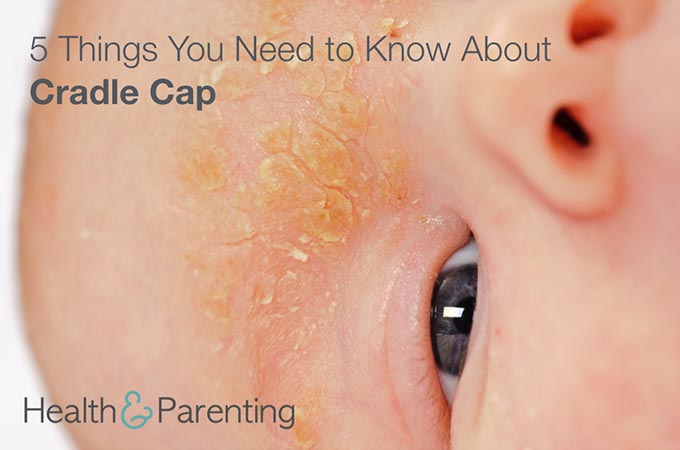If your baby’s scalp is covered in thick, oily yellow or brown scaling, dry flaky skin or crusting patches, it could be cradle crap. It’s not particularly pleasing to the eye, but it is a harmless condition. Cradle cap is also known as infantile seborrhoeic dermatitis. If the cradle cap is noticeable, you may be wondering what you can do to rid your baby’s beautiful head of this unsightly condition. Here are five things you need to know about cradle cap:
- It’s a common condition
Cradle cap is a pretty common condition in young babies, and isn’t a cause for concern. You don’t need to take your baby to the doctor unless her scalp becomes inflamed or bleeds. These symptoms suggest the skin could be infected, and your doctor may prescribe an anti fungal cream to fight the infection.
- The cause is unknown
Doctors don’t yet know what causes cradle cap. Some experts think it could be caused by the maternal hormones babies are exposed to during the final week of pregnancy, though this has not been proven. What they do know is that the condition isn’t caused by poor hygiene. Cradle cap is not a reflection of your parenting skills, it’s simply a common condition that affects a lot of babies.
- It can become infected
If you have an overwhelming urge to pick the cradle cap from your baby’s head, don’t. Picking cradle cap can cause it to become infected, which won’t be pleasant for either you or your baby. Fight the urge to pick the flakes, and instead either leave it alone, or try one of the gentler methods suggested below.
- There are other things you can do
If you’re desperate to rid your baby’s head of crusty scales, there are a few things you can try. Gently massaging natural baby oil into your baby’s scalp can help to soften the flakes. You should leave the oil on for about 15 minutes before gently combing your baby’s hair (or, if your baby is not forthcoming in the hair department, massaging her scalp) with a soft baby brush. This should help to remove any loose flakes. Once you’re done, gently wash your baby’s hair with baby shampoo to remove any leftover oil. You could also try some over the counter remedies, there are a number of shampoos specially formulated to treat cradle cap. Speak to your pharmacist for advice about which product to choose.
- It will disappear eventually
Most cases of cradle cap resolve themselves before the baby’s first birthday. Some babies only have cradle cap for a few weeks, and others avoid it entirely. For some, however, the condition can last long into toddlerhood. You don’t need to worry too much about it, cradle cap will disappear eventually and isn’t doing your baby any harm.
Written by Fiona (@Fiona_Peacock), mother, writer and lover of all things baby related.
This information is not intended to replace the advice of a trained medical doctor. Health & Parenting Ltd disclaims any liability for the decisions you make based on this information, which is provided to you on a general information basis only and not as a substitute for personalized medical advice. All contents copyright © Health & Parenting Ltd 2016. All rights reserved.










